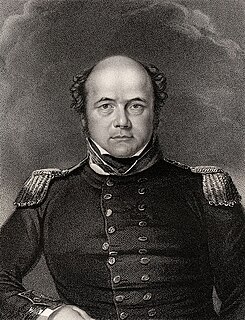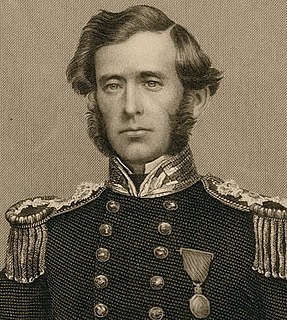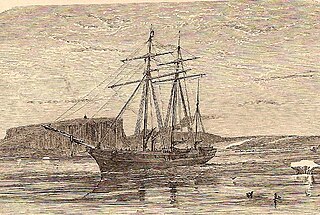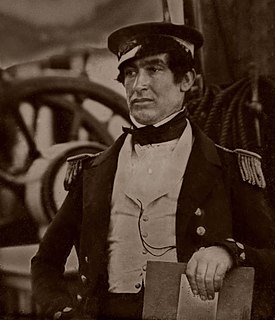
The Northwest Passage (NWP) is the sea route between the Atlantic and Pacific oceans through the Arctic Ocean, along the northern coast of North America via waterways through the Canadian Arctic Archipelago. The eastern route along the Arctic coasts of Norway and Siberia is accordingly called the Northeast Passage (NEP). The various islands of the archipelago are separated from one another and from Mainland Canada by a series of Arctic waterways collectively known as the Northwest Passages or Northwestern Passages.

John Rae was a Scottish surgeon who explored parts of northern Canada.

Sir John Franklin was a British Royal Navy officer and Arctic explorer. After serving in wars against Napoleonic France and the United States, he led two expeditions into the Canadian Arctic and through the islands of the Arctic Archipelago, in 1819 and 1825, and served as Lieutenant-Governor of Van Diemen's Land from 1839 to 1843. During his third and final expedition, an attempt to traverse the Northwest Passage in 1845, Franklin's ships became icebound off King William Island in what is now Nunavut, where he died in June 1847. The icebound ships were abandoned ten months later and the entire crew died, from causes such as starvation, hypothermia, and scurvy.

Melville Island is an uninhabited island of the Arctic Archipelago with an area of 42,149 km2 (16,274 sq mi). It is the 33rd largest island in the world and Canada's eighth largest island.

HMS Resolute was a mid-19th-century barque-rigged ship of the British Royal Navy, specially outfitted for Arctic exploration. Resolute became trapped in the ice and was abandoned in 1854. Recovered by an American whaler, she was returned to Queen Victoria in 1856. Timbers from the ship were later used to construct the Resolute desk which was presented to the President of the United States and is currently located in the White House Oval Office.

Admiral Sir Edward Belcher was a British naval officer, hydrographer, and explorer. Born in Nova Scotia, he was the great-grandson of Governor Jonathan Belcher.

Sir Francis Leopold McClintock was an Irish explorer in the British Royal Navy, known for his discoveries in the Canadian Arctic Archipelago. He confirmed explorer John Rae's controversial report gathered from Inuit sources on the fate of Franklin's lost expedition, the ill-fated Royal Navy undertaking commanded by Sir John Franklin in 1845 attempting to be the first to traverse the Northwest Passage.

Francis Rawdon Moira Crozier was an Irish officer of the Royal Navy and polar explorer who participated in six expeditions to the Arctic and Antarctic. In May 1845, he was second-in-command to Sir John Franklin and captain of HMS Terror during the Franklin expedition to discover the Northwest Passage, which ended with the loss of all 129 crewmen in mysterious circumstances.

Sir Richard Collinson was an English naval officer and explorer of the Northwest Passage.

Franklin's lost expedition was a failed British voyage of Arctic exploration led by Captain Sir John Franklin that departed England in 1845 aboard two ships, HMS Erebus and HMS Terror, and was assigned to traverse the last unnavigated sections of the Northwest Passage in the Canadian Arctic and to record magnetic data to help determine whether a better understanding could aid navigation. The expedition met with disaster after both ships and their crews, a total of 129 officers and men, became icebound in Victoria Strait near King William Island in what is today the Canadian territory of Nunavut. After being icebound for more than a year Erebus and Terror were abandoned in April 1848, by which point Franklin and nearly two dozen others had died. The survivors, now led by Franklin's second-in-command, Francis Crozier, and Erebus's captain, James Fitzjames, set out for the Canadian mainland and disappeared having presumably perished.

The Fox was an 1854 steam yacht commanded by Leopold McClintock on a privately funded 1857–1859 expedition to the North American Arctic Archipelago to search for clues about the fate of Franklin's lost expedition.

The Second Grinnell expedition of 1853–1855 was an American effort, financed by Henry Grinnell, to determine the fate of the Franklin's lost expedition. Led by Elisha Kent Kane, the team explored areas northwest of Greenland, now called Grinnell Land.
The First Grinnell expedition of 1850 was the first American effort, financed by Henry Grinnell, to determine the fate of the lost Franklin Northwest Passage expedition. Led by Lieutenant Edwin De Haven, the team explored the accessible areas along Franklin's proposed route. In coordination with British expeditions, they identified the remains of Franklin's Beechey Island winter camp, providing the first solid clues to Franklin's activities during the winter of 1845, before becoming icebound themselves.

The McClure Arctic expedition of 1850, among numerous British search efforts to determine the fate of the Franklin's lost expedition, is distinguished as the voyage during which the Irish explorer Robert McClure became the first person to confirm and transit the Northwest Passage by a combination of sea travel and sledging.
The Rae–Richardson Arctic expedition of 1848 was an early British effort to determine the fate of the lost Franklin Polar Expedition. Led overland by Sir John Richardson and John Rae, the team explored the accessible areas along Franklin's proposed route near the Mackenzie and Coppermine rivers.

Vice-Admiral William John Samuel Pullen was a Royal Navy officer who was the first European to sail along the north coast of Alaska from the Bering Strait to the Mackenzie River in Canada. His 1849 journey was one of the many unsuccessful expeditions to rescue Sir John Franklin and explore the Northwest Passage.

Thomas Abernethy was a Scottish seafarer, gunner in the Royal Navy, and polar explorer. Because he was neither an officer nor a gentleman, he was little mentioned in the books written by the leaders of the expeditions he went on, but was praised in what was written. In 1857, he was awarded the Arctic Medal for his service as an able seaman on the 1824–25 voyage of HMS Hecla, the first of his five expeditions for which participants were eligible for the award. He was in parties that, for their time, reached the furthest north, the furthest south (twice), and the nearest to the South Magnetic Pole. In 1831, along with James Clark Ross's team of six, Abernethy was in the first party ever to reach the North Magnetic Pole.

Graham Gore was an English officer of the Royal Navy and polar explorer who participated in two expeditions to the Arctic and a survey of the coastline of Australia aboard HMS Beagle. In 1845 he served under Sir John Franklin as First Lieutenant on the Erebus during the Franklin expedition to discover the Northwest Passage, which ended with the loss of all 129 officers and crewmen in mysterious circumstances.

Henry Thomas Dundas Le Vesconte was an English officer of the Royal Navy and polar explorer who from 1845 served under Sir John Franklin as Second Lieutenant on the Erebus during the Franklin expedition to discover the Northwest Passage, which ended with the loss of all 129 crewmen in mysterious circumstances.





















